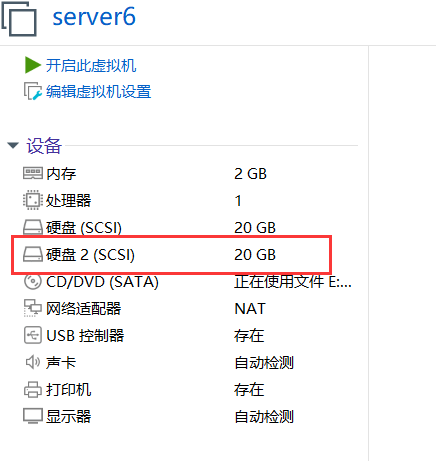环境准备:六台节点
一台管理节点
- server1
一台nginx作为负载均衡器
- server2
两台apache作为web服务器
- server3
- server4
一台作为mariadb数据库
- server5
一台作为网站存储(nfs)
- server6
- 工作流程(主机清单文件、ssh通信、免密登录)
- 安装httpd、mariadb、nginx
- 使用模板给httpd准备配置文件,使用ansible-galaxy安装负载均衡角色
- 使用parted模块创建分区,使用lvg模块创建卷组,使用lvol模块创建逻辑卷,逻辑卷作为nfs存储使用
- 为数据库添加指定库、用户等操作
安装ansible(所有主机)
[root@server1 ~]# yum install -y epel-release.noarch
#安装拓展包
[root@server1 ~]# yum install -y ansible在管理节点编写ansible主机清单文件
[root@server1 ~]# yum install -y ansible
[root@server1 ~]# vim /etc/ansible/hosts
[all_ip]
192.168.106.10
192.168.106.20
192.168.106.30
192.168.106.40
192.168.106.50
192.168.106.60
[all_hostname]
server2
server3
server4
server5
server6
[nginx]
server2
[apache]
server3
server4
[mariadb]
server5
[nfs]
server6
#生成密钥,分发密钥
[root@server1 ~]# ssh-keygen
[root@server1 .ssh]# for i in {1..6};do ssh-copy-id -i id_rsa.pub root@192.168.106.${i}0;donePS:bash: ssh-copy-id: command not found的解决方法
yum -y install openssh-clients为所有主机生成hosts解析文件
[root@server1 ~]# mkdir playbook
[root@server1 ~]# mkdir template
[root@server1 playbook]# vim /root/template/hosts.j2
127.0.0.1 localhost localhost.localdomain localhost4 localhost4.localdomain4
::1 localhost localhost.localdomain localhost6 localhost6.localdomain6
{% for host in groups.all_ip %}
{{hostvars[host].ansible_ens33.ipv4.address}} {{hostvars[host].ansible_hostname}}
{% endfor %}
[root@server1 ~]# cd playbook
[root@server1 playbook]# vim hosts.yml
- name: Config hosts file
hosts: all_ip
remote_user: root
tasks:
- name: copy hosts.j2 to group servers
template:
src: /root/template/hosts.j2
dest: /etc/hosts
[root@server1 playbook]# ansible-playbook hosts.yml编写nginx、httpd、mariadb角色
编写yml安装nginx、httpd、mariadb并打开防火墙,设置防火墙放行服务
[root@server1 playbook]# ansible-galaxy init /etc/ansible/roles/apache
- Role /etc/ansible/roles/apache was created successfully
[root@server1 playbook]# ansible-galaxy init /etc/ansible/roles/nginx
- Role /etc/ansible/roles/nginx was created successfully
[root@server1 playbook]# ansible-galaxy init /etc/ansible/roles/mariadb
- Role /etc/ansible/roles/mariadb was created successfully
[root@server1 playbook]# ansible-galaxy init /etc/ansible/roles/nfs
- Role /etc/ansible/roles/nfs was created successfully
#初始化三个角色
#nginx
[root@server1 ~]# vim /etc/ansible/roles/nginx/tasks/main.yml
---
# tasks file for /etc/ansible/roles/nginx
- name: Yum install epel
yum:
name: epel-release.noarch
state: present
- name: Yum install nginx
yum:
name: nginx
state: present
- name: Start nginx
service:
name: nginx
state: restarted
enabled: yes
[root@server1 playbook]# vim nginx_install.yml
- name: Install nginx
hosts: nginx
roles:
- nginx
[root@server1 playbook]# ansible-playbook nginx_install.yml
#apache
[root@server1 playbook]# vim /etc/ansible/roles/apache/tasks/main.yml
---
# tasks file for /etc/ansible/roles/apache
- name: Install lamp environment
yum:
name: httpd,php-fpm,php-mysql,mod_php
state: present
- name: Start httpd
service:
name: httpd
state: restarted
- name: Start php-fpm
service:
name: php-fpm
state: restarted
[root@server1 playbook]# vim lamp_install.yml
- name: Prepare lamp
hosts: apache
roles:
- apache
[root@server1 playbook]# ansible-playbook lamp_install.yml
#mariadb
[root@server1 playbook]# vim /etc/ansible/roles/mariadb/tasks/main.yml
---
# tasks file for /etc/ansible/roles/mariadb
- name: Yum install mariadb
yum:
name: mariadb-server
state: present
- name: Start mariadb
service:
name: mariadb
state: restarted
[root@server1 playbook]# vim mariadb_install.yml
- name: Install mariadb
hosts: mariadb
roles:
- mariadb
[root@server1 playbook]# ansible-playbook mariadb_install.yml 准备负载均衡角色
#初始化角色
[root@server1 playbook]# ansible-galaxy init /etc/ansible/roles/nginx_lb
#准备配置文件模板
[root@server1 playbook]# vim /etc/ansible/roles/nginx_lb/templates/lb.conf.j2
upstream websers{
server server3;
server server4;
}
server{
listen 8080;
server_name 192.168.106.20:8080;
location / {
proxy_pass http://websers;
proxy_set_header HOST $host;
proxy_set_header X-Forwarded-Proto $scheme;
proxy_set_header X-Real-IP $remote_addr;
proxy_set_header X-Forwarded-For $proxy_add_x_forwarded_for;
}
}
#准备task文件
[root@server1 playbook]# vim /etc/ansible/roles/nginx_lb/tasks/main.yml
---
# tasks file for /etc/ansible/roles/nginx_lb
- name: Configure ngin LB conf file
template:
src: /etc/ansible/roles/nginx_lb/templates/lb.conf.j2
dest: /etc/nginx/conf.d/lb.conf
- name: Restart nginx
service:
name: nginx
state: restarted
[root@server1 playbook]# vim nginx_lb.yml
- name: Configure nginx lb server
hosts: nginx
roles:
- nginx_lb
[root@server1 playbook]# ansible-playbook nginx_lb.yml 创建逻辑卷作为nfs存储使用
给server6添加新磁盘

[root@server1 playbook]# vim nfs.yaml
- name: create vg
hosts: nfs
tasks:
- name: create partition
parted:
device: /dev/sdb
number: 1
flags: [ lvm ]
state: present
part_start: 1MiB
part_end: 2GiB
- name: create nfs vg
lvg:
vg: nfs
pvs: /dev/sdb1
- name: create lv
block:
- name: create lvm 1500m
lvol:
vg: nfs
lv: data
size: 1900m
rescue:
- name: file msg
debug:
msg: create lv failed
- name: create lvm 800m
lvol:
vg: nfs
lv: data
size: 800m
always:
- name: format lvm
filesystem:
fstype: ext4
dev: /dev/nfs/data
when: "'nfs' in ansible_lvm.vgs"
- name: nfs not exists
debug:
msg: vg does not exist
when: "'nfs' not in ansible_lvm.vgs"
- name: install nfs pkg and mount nfs lvs
hosts: nfs,apache
tasks:
- name: install package
yum:
name: nfs-utils,rpcbind
state: latest
- name: config file
shell: mkdir /nfs | chmod 777 /nfs | echo "/nfs 192.168.106.0/24(rw,sync,no_root_squash)" > /etc/exports
- name: start services
service:
name: "{{ item }}"
state: restarted
loop:
- rpcbind
- nfs-server
- name: mount lv
hosts: nfs
tasks:
- name: mount lv
mount:
src: /dev/nfs/data
path: /nfs
fstype: ext4
state: mounted
- name: mount apache
hosts: apache
tasks:
- name: mount apache
mount:
src: 192.168.106.60:/nfs
path: /var/www/html
fstype: nfs
state: mounted
[root@server1 playbook]# ansible-playbook nfs.yml
#此时apache的两台服务器就实现了共享存储,/var/www/html这个挂载在/nfs下共享web服务器的文件
[root@server3 ~]# df -h
[root@server3 ~]# echo "hello apache" >> /var/www/html/index.html
[root@server4 ~]# cat /var/www/html/index.html
hello apache在nfs服务器nfs目录下下载typecho软件包并解压
[root@server3 nfs]# cd /var/www/html/
[root@server3 html]# wget http://typecho.org/downloads/1.1-17.10.30-release.tar.gz
[root@server3 html]# tar -zxvf 1.1-17.10.30-release.tar.gz
[root@server3 html]# mv build/* .为数据库添加指定库、用户
[root@server5 ~]# mysql -uroot
MariaDB [(none)]> create database typecho;
MariaDB [(none)]> grant all privileges on typecho.* to user1@"%" identified by '123456';
MariaDB [(none)]> flush privileges;
测试
最后网址访问nginx负载均衡服务器:192.168.106.20:8080(负载均衡不用80端口似乎会有bug,如果出问题就去访问192.168.106.30或者192.168.106.40)



Comments | NOTHING